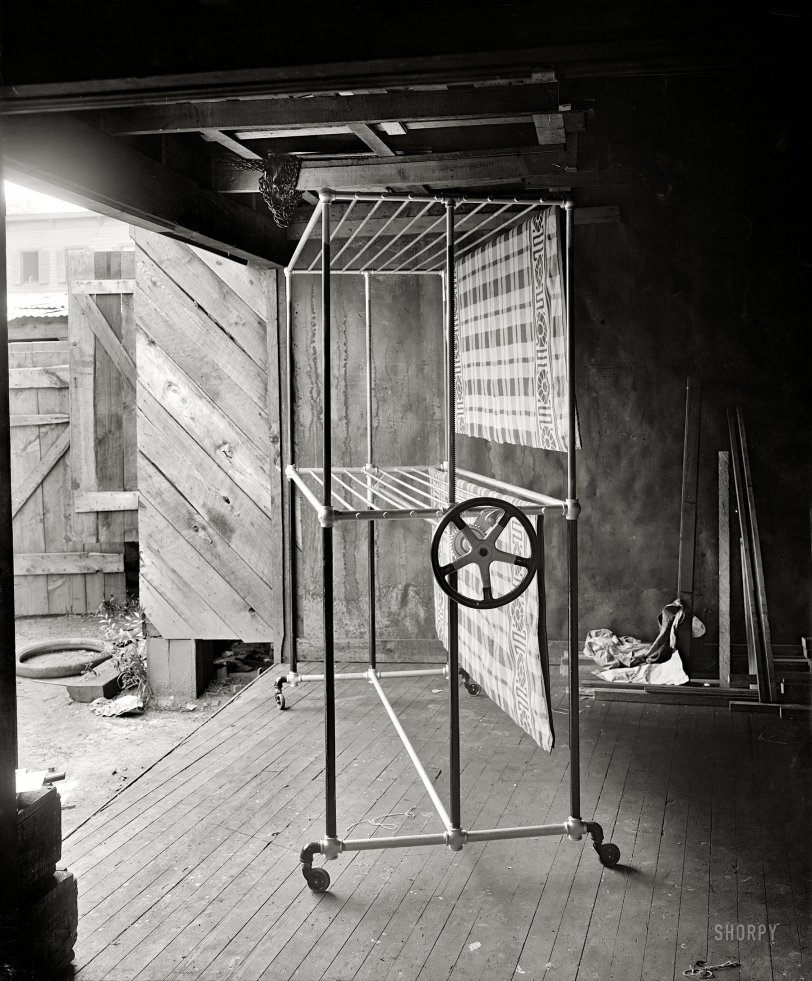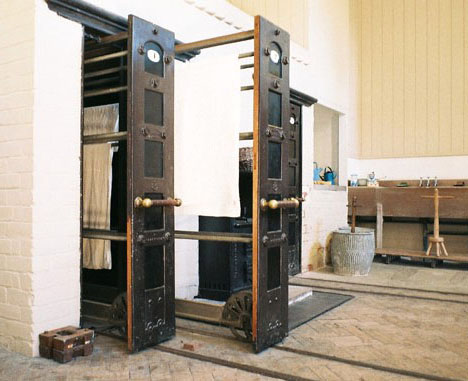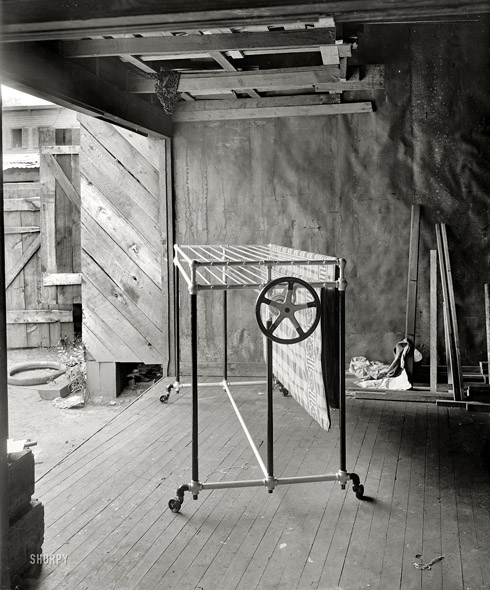


Framed or unframed, desk size to sofa size, printed by us in Arizona and Alabama since 2007. Explore now.
Shorpy is funded by you. Patreon contributors get an ad-free experience.
Learn more.

- Baldwin 62303
- Baldwin VO-1000
- Cold
- No expense spared
- Tough Guys
- Lost in Toyland
- And without gloves
- If I were a blindfolded time traveler
- Smoke Consumer Also Cooks
- Oh that stove!
- Possibly still there?
- What?!?
- $100 Reward
- Freeze Frame
- Texas Flyer wanted
- Just a Year Too Soon
- WWII -- Replacing men with women at the railroad crossing.
- Yes, Icing
- You kids drive me nuts!
- NOT An Easy Job
- I wonder
- Just add window boxes
- Icing Platform?
- Indiana Harbor Belt abides
- Freezing haze
- Corrections (for those who care)
- C&NW at Nelson
- Fallen Flags
- A dangerous job made worse
- Water Stop
Print Emporium
Abe Cohen: 1922

Washington, D.C., circa 1922. "Abe Cohen." Probably not Abe himself, but you never know. This is just the kind of malevolent-looking contraption that keeps Stephen King in business. National Photo glass negative. View full size.
Maker of Machinery
Washington Post, August 22, 1949.
Abe Cohen, 71, Dies;
Maker of MachineryAbraham (Abe) Cohen, 71, senior member of the firm of Abe Cohen & Son, Arlington, Va., manufacturers of commercial laundry machines, died yesterday at Garfield Hospital after seven weeks' illness.
Funeral services will be held at his home, 1437 Geranium st. nw. Burial will follow in the Washington Hebrew Congregation Cemetery.
Well known in the United States and Canada, he had been associated with the laundry business for 50 years, and a member of the firm that bears his name for the past two decades.
He was born in Glasgow, Scotland, and came to America at an early age. Cohen was a member of St. Johns Lodge No. 11 of the F.A.A.M., Almas Temple of the A.A.O.M.A., a 32nd-degree member of the Scottish Rite, the Washington Lodge No. 15 of the B.P.O.E. and the Rosslyn Business Men's Association.
Surviving are a son, Moritz. A. Cohen sr., two grandchildren, Moritz A. Cohen jr. and Virginia Louise Cohen, and 10 nieces and nephews, all of Washington.
Severely overengineered
This is an extendable clothes drying rack. The top half can be extended by a rack-and-pinion system. The rack gear can be seen on the vertical tubes in the middle. The ratchet wheel behind the hand wheel prevents the upper half from crashing down again.
I have a hunch that Abe Cohen may have been a pipe fitter, looking to branch out.
It's not overbuilt
If you're going to drip-dry eight woollen blankets (which is probably what this is for) you need something made out of steam pipe.
Its similar to the drying racks in the laundry of Berrington Hall, a country house in Herefordshire in England (see pic). You fill them up with clothes and slide them in on rails on either side of a special drying furnace.
Mind you - it would be a good place to hide a body too (but Miss Marple would know where to look).

Rug washing and drying
I read an article in the local newspaper about the oldest laundry and dry cleaner in my hometown. Back in the day, besides providing a laundry service for clothing, the company also washed rugs and hung them in the attic to dry.
This looks like a drying rack for area rugs (no wall to wall back in the day) with a height adjustment.
?????
I don`t know what it`s for, but the top half retracts into the bottom.
Curiosity Killing the Cat
Well Dave, are you gonna tell us what this creation is or not? Do you think its fair to put that out there with nary a clue or explanation? Is there a prize for figuring out why it was created? Why is the name "Abe Cohen" used in the title? Is that a steering wheel that can be driven in different directions? Why does it have wheels? What are the blankets for? Is it used with the chains wrapped up there in the rafters? What do you know about this that you are not telling? Inquiring minds want (and need) to know. Don't just leave us hanging.
Abe Cohen's Stage Name
was Ron Popeil! Anyone can clearly see that this is an early version of the "Bamboo Steamer!"
Stretcher / Drier?
Yeah, it seems to me like it's intended to keep something under tension as it dries. Not only is there a rack (as in a linear gear) and pinion arrangement to move the lower rods, but there's also a large toothed cog. It doesn't engage the rack (there's a smaller pinion for that), but there's a movable pawl that engages the cog to lock the whole arrangement in the desired position.
Based on the size of the crank wheel and the pawl arrangement and everything else, this looked like some serious muscle was used. I'm wondering if the fabric mats (?) hanging in the back may have been the sort of object dried here.
[Below, another view of the drying rack. The top half telescopes down into the bottom half. - Dave]
WMP
Weird mysterious photo, the kind I like.
To the Rack!
It's almost definitely a fabric stretcher. The ratchet on the hand wheel is directed to pull the lower rack down away from the upper one.
I find the chain wrapped around the rafter to be more sinister.
OY!
This looks like something in the oral surgeon's office my mother tricked me into "visiting" in the early 1950s. My mouth still hurts.
Goodbye, Mr Bond
So many weird devices on Shorpy bring those classic words to mind. Actually, I believe the wheel raises the upper rack. One reason to adjust it would be to bring it within reach - of Mr Cohen or his employees, his wife, or his zombie. It certainly could be used to stretch something, but I'll cast my vote for drying rack. Perhaps it was used at a hospital for drying linens, like those we see ... drying. Lots of overbuilt equipment in old hospitals - see any movie about shuttered mental institutions. Also, one-offs then and now were likely to be built out of whatever was at hand - perhaps pipes and a crank were just available and easily cobbled together.
Ink Jet
I think that’s what the inside of my printer looks like.
Wet rugs
One of my cousins owned a dry cleaning business, and they had the same contraption. It was used to dry wet rugs. You would be surprised just how heavy a wet rug is!
Anyone who has operated one of these drying racks can tell you that they aren't all that "heavy duty."
The wheel goes up and down with the rack. This means that when you raise the lower rack, the wheel is "over your head" (a real back breaker). The upper rack is stationary.
Abe needed a broom.
Looks to my eye like a drying rack. Abe could have used a rake as well.

























On Shorpy:
Today’s Top 5